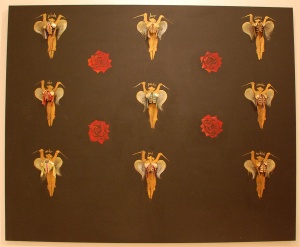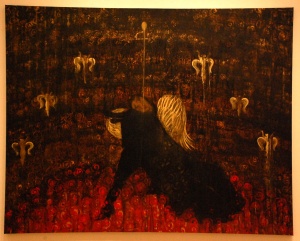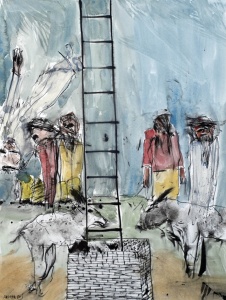Anette Pier and Michael Hafftka at YUM
Two deeply idiosyncratic exhibitions at Yeshiva University Museum warrant close inspection if only to show how the diverse richness of biblical and Judaic subject matter can inspire contemporary artists. The very eclectic nature of both artist’s works speaks volumes about the possibilities available when artists take Jewish subjects seriously and subsequently embrace them with their own demons.

Anette Pier, an artist who is also a physician and teacher in Mexico City, has produced what at first glance is a most curious midrashic understanding of the biblical Joseph in Joseph, The Bull, and the Rose. In Deuteronomy 33:17 Joseph is described as “A first-born bull in his majesty.” The artist recasts the primal narrative of Joseph and his brothers as fiesta brava, a bullfight. The 20 mixed media paintings symbolically narrate the strained and complex relationship of Jacob’s sons. Proceeding counter-clockwise around the gallery, the first painting, Joseph and his Brothers (Traje de Luces or Suit of Lights) depicts the brothers as nine insects, perhaps butterflies or angels pinned and arranged in neat rows on a black rough canvas. Four roses appear between them, alluding to the insect allure of Joseph homiletically compared to a rose (i.e. tzadik) in the Gemara in Sotah 36b. These figures are each dressed in tiny three-dimensional suits of lights, the traditional costume of the matador. Each brother is identified and, arms raised with the short pics, poised to strike.
Soon along in the exhibition we encounter Matador, a portrait of one of the brothers, dressed in his ornate costume and glaring out at the viewer. He is filled with pride and angst that communicates the brother’s hate and envy of the favored youngest son of Jacob.
Joseph the Tzadik digresses to symbolically present the conundrum of Joseph’s own troubled relationship with Potiphar’s wife. She is seen reclining in silhouette in the foreground, entrapped in roses while the bull Joseph is on the far side of the field surrounded by three rose orbs. Pier’s image implies that Joseph’s temptation was ultimately a reflection of his own beauty and sensitive nature exemplified by the symbol of the rose.
On the end wall two giant capota dominate the wall. One is mounted facing up, the other facing down. These sweeping matador’s capes are ultimately the symbol of the bull’s death, his last sight before the sword is thrust into his heart.
As the end approaches, Ole! Joseph shows the grand bull stumble before the matador in the bullring, a chilling metaphor for the pit of the condemned Joseph. The image is streaked with vertical lines as if someone has wept upon it.

Finally Joseph’s End. The bull is down, struggling in a field of blood red that becomes multiple paradoxical images of roses. An angel brother comforts Joseph the bull as a thin elegant sword protrudes from between his shoulders. Six more fluttering angelic brothers hover, triumphant, as the narrative comes to a close. In Anette Pier’s tragic cycle the metaphor does not allow us reconciliation. Joseph will not be freed from prison, he will not rule Egypt nor will he bring his father and brothers to safety. The brothers are fated to slay Joseph over and over again, throughout the centuries in bullfight after bullfight. She has taken their enmity to its logical, though non-biblical, conclusion.
Just up the stairs in the second large gallery at Yeshiva University Museum is Michael Hafftka’s exhibition I of the Storm. It consist of three inter-related groups of artwork: seven large oil paintings, (2007-2008, one from 1985); 22 watercolor and ink works on the Aleph-Bet (2006-2008) and finally an ongoing series of watercolor and ink works on the Zohar.
The works on the Hebrew alphabet are well done and entertaining. They range from the purely illustrational utilizing simple human figures interacting with the letters to more abstract designs that allow the letters to function as a kind of natural phenomena, like a tree or piece of sculpture in an environment. The Raish and Vav are favorites.
His works on the Zohar are considerably more complex. Hafftka prefaces this section by telling us that “Painting requires a state of intentional open-mindedness that often brings with it doubts and insecurities, similar to what John Keats called ‘negative capability.’” Each image is accompanied by a short text translated from the Zohar. Hafftka’s images strive not to illustrate the stories, rather they frequently act as a visual accompaniment, a reflection of where the text might be coming from or where it is going to. In the image of R. Elazar who places his head between the knees of his father we see in the expression of the son a kind of desperate trust, that somehow the awesome knowledge transmitted will not destroy him, that spiritual transmission will not be fatal.

In a story of what the sages did When sins Prevailed the artist has created a deeply disturbing image of a world askew. Two creatures approach a neatly built foundation upon which a ladder ascends. Figures mill about in the background, apparently unable to approach, either out of fear or indecision. The image addresses our conundrum when our sins prevent us from even approaching the ladder to heaven’s gate.
Hafftka’s oil paintings fully expose his neo-expressionistic aesthetic that has shown remarkable consistency from his 1985 painting The Hill – Jerusalem. This impressive work, approximately 6 by 21 feet, dominates the gallery and presents a horrific vision of violence and struggle contrasted by a glimpse of hope in the presence of two levitating figures on the right side. Perhaps a crown and scepter are in their grasp, just beginning to mitigate the scene of war and chaos directly to the left. Skeletal and bloody against a black background, the figures echo the many who have died to preserve our holy city.

In what is easily the most powerful painting in the exhibition, Honi ha Magil (2008) the full power of Hafftka’s expression is unleashed. In its clarity and freedom it best captures the spirit of the disrespectful miracle worker found in the Gemara in Taanis 23a. The genius in this depiction is that it avoids any picturesque details of Honi’s exploits. Instead great slashes of painterly energy tear across the canvas, simultaneously emanating from the figure himself and a Divine force field that surrounds his defiant circle. Honi’s head is transfigured, passionate and torn as he pleads the cause of his Jewish brethren. This is truly a case where the expressiveness of a painting obliterates the need for narrative specifics.
Each in their own way, both of these exhibitions engage in a dialogue with the unknown. Anette Pier immerses the biblical Joseph in her Mexican culture and plumbs the depths of fraternal enmity and envy. Hafftka finds in his own passions and demons a parallel force that motives holy men and sinners alike. Each has appropriated the biblical and made it their own and shown us a side we could not have imagined otherwise.
Yeshiva University Museum – Center for Jewish History
15 West 16th Street, New York, N.Y.